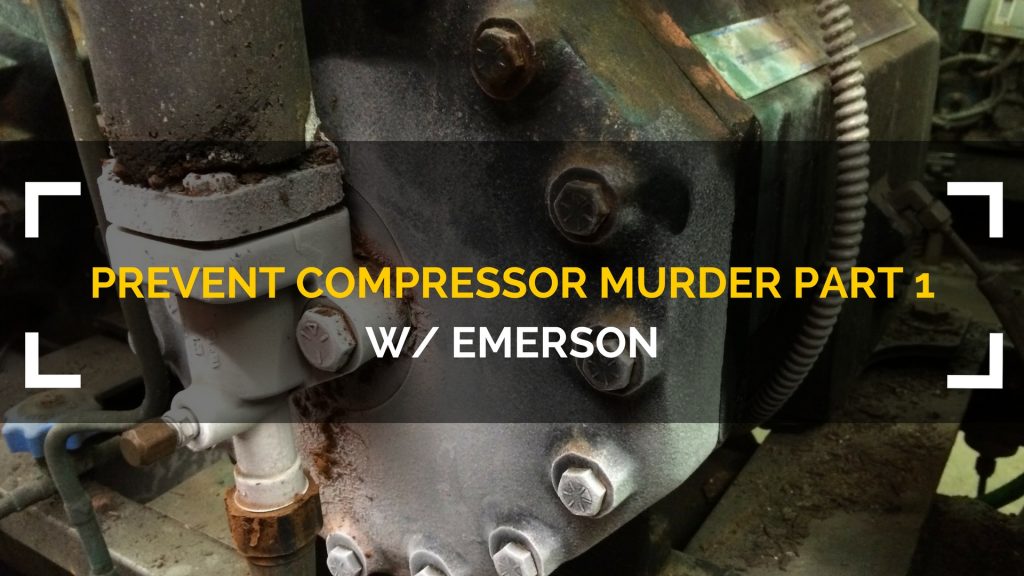Prevent Compressor Murder Part 1 & 2 w/ Emerson (Podcast)

Part 1:
In today's podcast, we talk with Trevor Matthews with Emerson. He tells us about the causes and prevention of air conditioning and refrigeration compressor failure.
Most compressors don't die a natural death… they're murdered. Of course, that's to say that installation and maintenance play a major role in the compressor's operation and lifespan. Electrical and mechanical failures are the two broad causes of compressor failure.
When it comes to electrical failures, Trevor often sees single-phase compressors fail early when their electrical components don't receive proper inspections and care. For example, contactors may go too long without inspection or replacement. Three-phase compressors are also prone to phasing issues and may run backward.
Common mechanical failures deal with oil in the system. Oil lubricates the bearings inside the compressor. Unfortunately, that oil can mix with liquid refrigerant, become diluted, or experience acid contamination. Some oil-related failures include floodback, flooded starts, slugging, overheating, oil loss, and contamination. Compressors cannot compress liquids, so many of them fail when the refrigerant condenses to a liquid inside the compressor.
Many failures occur because technicians don't think they have enough time to troubleshoot or inspect the whole system. Trevor recommends setting up a checklist with all of the tests you need to perform.
Trevor also discusses:
- Service replacement compressors vs. OEM compressors
- Megohmmeter usage
- Causes of floodback/flooded starts
- Compressor superheat
- Suction accumulators
- Bearing wear
- Temperature control and pump cycles for controlling flooded starts
Part 2:
Here is part 2 of the discussion with Trevor Matthews about the causes and prevention of air conditioning and refrigeration compressor failure.
Slugging occurs when the compressor attempts to compress oil or liquid refrigerant. A telltale sign of slugging is valve plate damage. On a semi-hermetic compressor, you can remove the screws on the head to access the valve plate. Wrist pin wear occurs during slugging the wrist pin is between the rod and the piston; you should test the wrist pin to see if it makes a knocking sound before you dismiss all other possibilities and replace the valve plate.
Overheating occurs when there is a system-related issue. Compression ratio is an indicator of overheating, but few technicians check it often enough. A requirement for external cooling and dirty condenser coils can cause overheating. Overheating also causes oil issues; when a compressor gets too hot, oil breaks down and loses its ability to lubricate the bearings.
Oil loss is a tricky cause for failure; it is hard to notice without a sight glass. Short-cycling can lead to oil loss over time, and bearings will begin to wear when there isn't enough oil to lubricate them.
Contamination usually occurs when moisture corrodes the copper plating and introduces acid to the system. Acid and sludge are the most common contaminants. Proper reaming practices also keep copper out of the system and reduce the risk of acid contamination.
Trevor also discusses:
- Slugging in scroll compressors
- Sight glasses and oil measurement
- System load and suction pressure
- Maintaining design compression ratio
- “Blow by”
- Oil separators
- Replacing line dryers
- Components to troubleshoot and inspect
Resources:
Check out the Copeland mobile app HERE.
Emerson's 93-11 Refrigerants and Lubricants for Copeland Compressors: https://climate.emerson.com/documents/refrigerants-lubricants-approved-for-use-in-copeland-compressors-93-11-en-5340874.pdf
Diagnosing Compressor Failures from Emerson: https://hvacrschool.com/CompFailures
If you have an iPhone, subscribe to the podcast HERE, and if you have an Android phone, subscribe HERE.
Author:










Comments
I have a Carrier Condenser model 38TDA, equipped with a reciprocating compressor (Copeland-Two speed), R22 precharged from the factory. The unit was acquired 20 years ago and it is still in its original packaging, sealed and never been used. I want to install it. Is there an issue with the Compressor, the compressor oil or the refrigerant charge or the included TXV from been stored for that long?
I have a Carrier Condenser model 38TDA, equipped with a reciprocating compressor (Copeland-Two speed), R22 precharged from the factory. The unit was acquired 20 years ago and it is still in its original packaging, sealed and never been used. I want to install it. Is there an issue with the Compressor, the compressor oil or the refrigerant charge or the included TXV from been stored for that long?
To leave a comment, you need to log in.
Log In